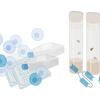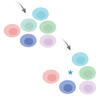Raghuvir Viswanatha, Roderick Brathwaite, Yanhui Hu, Zhongchi Li, Jonathan Rodiger, Pierre Merckaert, Verena Chung, Stephanie E Mohr, and Norbert Perrimon. 2019. “
Pooled CRISPR Screens in Drosophila Cells.” Curr Protoc Mol Biol, 129, 1, Pp. e111.
AbstractHigh-throughput screens in Drosophila melanogaster cell lines have led to discovery of conserved gene functions related to signal transduction, host-pathogen interactions, ion transport, and more. CRISPR/Cas9 technology has opened the door to new types of large-scale cell-based screens. Whereas array-format screens require liquid handling automation and assay miniaturization, pooled-format screens, in which reagents are introduced at random and in bulk, can be done in a standard lab setting. We provide a detailed protocol for conducting and evaluating genome-wide CRISPR single guide RNA (sgRNA) pooled screens in Drosophila S2R+ cultured cells. Specifically, we provide step-by-step instructions for library design and production, optimization of cytotoxin-based selection assays, genome-scale screening, and data analysis. This type of project takes ∼3 months to complete. Results can be used in follow-up studies performed in vivo in Drosophila, mammalian cells, and/or other systems. © 2019 by John Wiley & Sons, Inc. Basic Protocol: Pooled-format screening with Cas9-expressing Drosophila S2R+ cells in the presence of cytotoxin Support Protocol 1: Optimization of cytotoxin concentration for Drosophila cell screening Support Protocol 2: CRISPR sgRNA library design and production for Drosophila cell screening Support Protocol 3: Barcode deconvolution and analysis of screening data.


